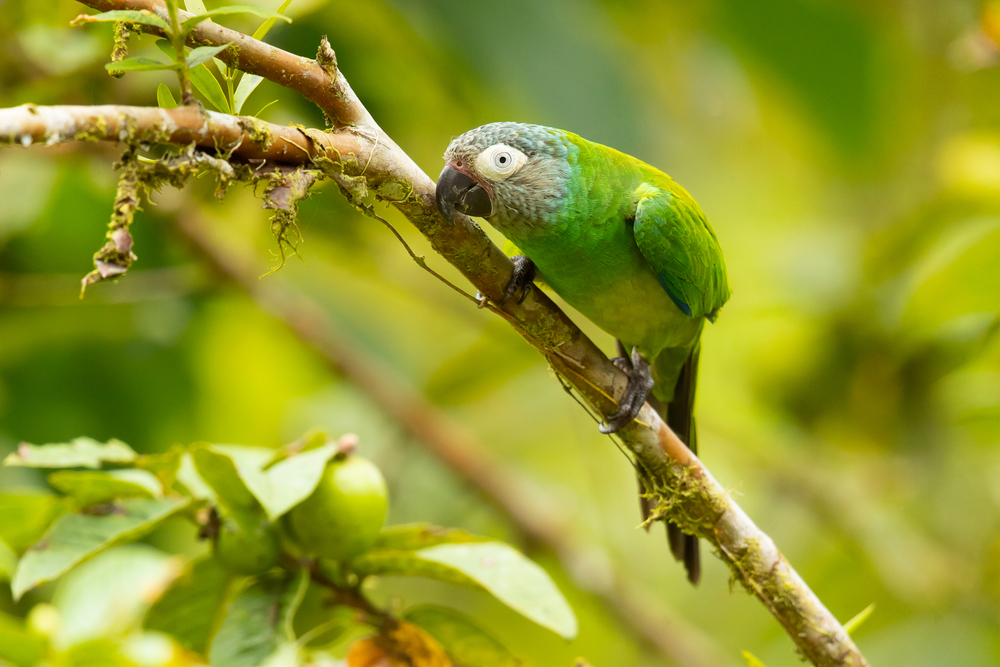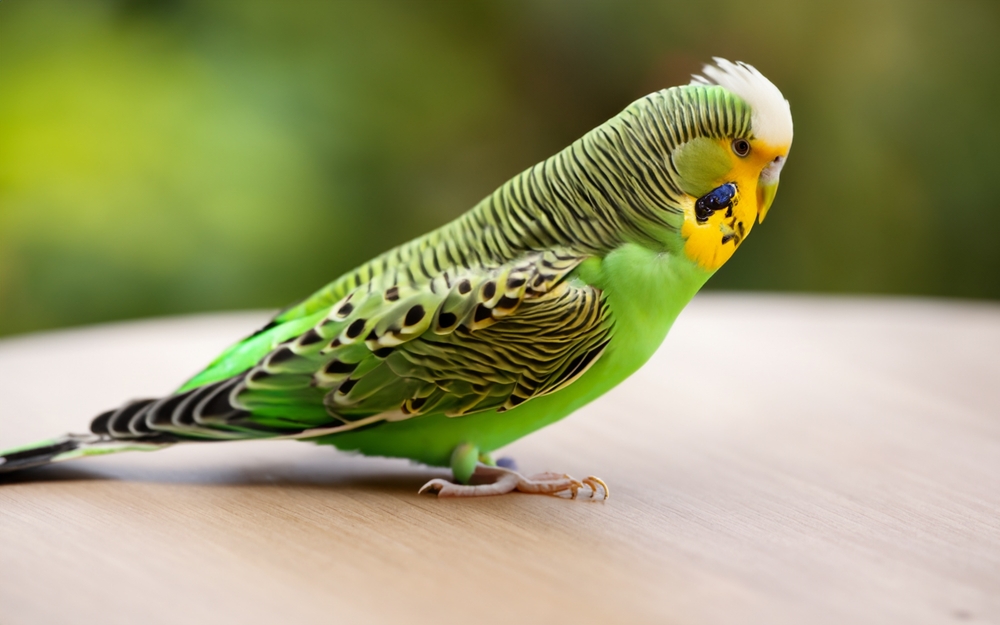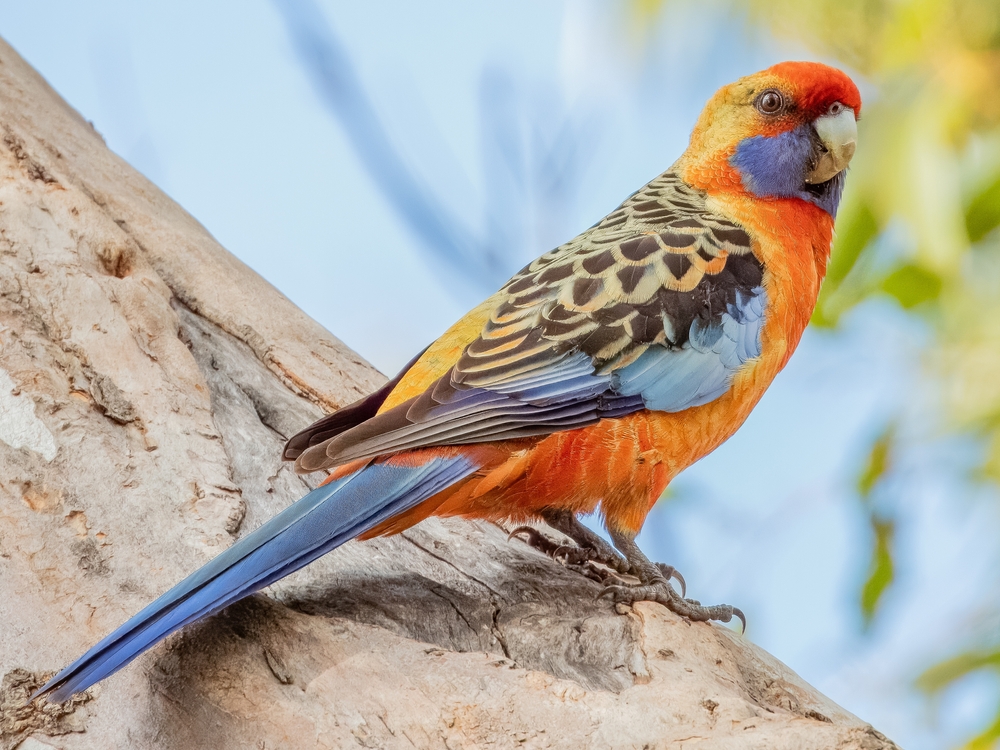Its closest relatives are other Aratinga (conure) species, particularly the White-eyed Parakeet (Aratinga leucophthalma) and Sun Parakeet (Aratinga solstitialis). They share similar size, flocking behavior, and social vocalizations.
About
The Dusky-headed Parakeet (Aratinga weddellii) is a lively and social member of the Psittacidae family, native to the western Amazon Basin of South America. Its range extends across Colombia, Ecuador, Peru, Bolivia, and western Brazil, where it inhabits lowland rainforests, forest edges, savannas, and riverine woodlands. Known locally as the Weddell’s Parakeet, it is admired for its charming personality and adaptability to diverse habitats.
This medium-sized parakeet measures about 27 to 28 centimeters (10.5 to 11 inches) in length. Its plumage is predominantly bright green, with a dusky-grey head that gives the species its name. Blue flight feathers and a pale eye-ring add further distinction. Compared to the brighter coloration of many other parakeets, its more subdued appearance makes it unique while still vibrant in tropical settings.
Dusky-headed Parakeets are highly social and are typically found in pairs, small groups, or large flocks that may number into the hundreds, especially near feeding grounds. Their diet includes fruits, seeds, flowers, berries, and cultivated crops, which occasionally brings them into conflict with farmers. They play a vital ecological role in seed dispersal, contributing to the regeneration of Amazonian forests.
Breeding usually takes place in tree cavities, where the female lays three to five eggs. Incubation lasts around four weeks, and both parents participate in raising the young. The species is known for its strong pair bonds and cooperative flock dynamics.
The Dusky-headed Parakeet is classified as Least Concern due to its wide distribution and stable population, though it faces threats from deforestation and the illegal pet trade. In captivity, it is valued for its gentle temperament and ability to mimic sounds, though it requires extensive social interaction and stimulation.
Admired for its beauty, intelligence, and flocking behavior, the Dusky-headed Parakeet remains a captivating representative of South America’s rich parrot diversity.
Physical Characteristics
The Dusky-headed Parakeet, also known as Weddell’s Conure, is a medium-sized parrot native to the western Amazon Basin, easily recognized by its contrasting head coloration.
Plumage: Adults have a distinctive grayish-brown head and neck, which contrasts sharply with the bright green body plumage. The wings are green with blue primaries, and the tail is long, narrow, and mostly green with bluish tips. The underparts are a lighter green, sometimes with a slight yellowish wash.
Head & Beak: The head is dusky gray, giving the species its name, with a small pale eye-ring around orange-brown eyes. The beak is horn-colored (pale grayish-beige), strong, and slightly hooked, adapted for cracking seeds and fruits.
Body & Wings: The body is slender, with long, pointed wings designed for swift flight through forest edges and open areas. The long, tapered tail provides additional agility in flight.
Size:
-
Length (Body and Tail): 11–12 in (28–30 cm)
-
Wingspan: About 6.5–7.5 in (17–19 cm) per wing
-
Tail Length: 5–6 in (13–15 cm)
Weight:
-
Adult Male and Female: 3.5–4.9 oz (100–140 g)
The Dusky-headed Parakeet’s combination of a grayish head, bright green body, and long tail feathers makes it easily distinguishable from other South American parakeets, especially when flying in noisy, active flocks.
Reproduction
The Dusky-headed Parakeet is a social and cavity-nesting parrot, with its breeding cycle tied to seasonal rainfall and food availability in the Amazon Basin.
1. Mating and Courtship:
Pairs are monogamous and often form long-term bonds. Courtship involves mutual preening, food sharing, and synchronized calls. Pairs often remain close within flocks, even during breeding.
2. Breeding Season:
Breeding generally occurs in the rainy season (November to March), when food such as fruits and seeds is abundant.
3. Nesting:
They nest in tree cavities, palm stumps, or old woodpecker holes, typically several meters above ground. Occasionally, they adapt to artificial nest sites. Nests are simple, unlined hollows.
4. Egg Laying and Incubation:
The female lays 3–5 white eggs. Incubation lasts about 23–26 days, performed mainly by the female, while the male supplies food and guards the territory.
5. Hatching and Chick Development:
Chicks hatch blind and helpless, covered in sparse down. The female broods them during the first week, while both parents feed them through regurgitation.
6. Fledging:
Young fledge at about 7–8 weeks, leaving the nest but remaining dependent on parents for several more weeks as they develop foraging skills.
7. Sexual Maturity:
Dusky-headed Parakeets reach breeding age at about 2–3 years, when they join the breeding population within flocks.
The Dusky-headed Parakeet’s reliance on tree cavities makes it vulnerable to deforestation, as the loss of mature trees reduces nesting opportunities in its Amazonian range.
Lifespan
The Dusky-headed Parakeet is a moderately long-lived parrot, with survival closely linked to flock dynamics, predation, and habitat conditions in the Amazon Basin.
Lifespan in the Wild:
In natural conditions, Dusky-headed Parakeets typically live 10–15 years. Many juveniles are lost to predation or accidents during their first years, but adults that survive to establish themselves in flocks often live a decade or longer.
Lifespan in Captivity:
With consistent food, veterinary care, and safe housing, they can live up to 20–25 years, and occasionally longer. Enrichment and social interaction are important to maintain their health and reduce stress.
Threats to the Dusky-headed Parakeet:
-
Habitat Loss: Deforestation and removal of large trees reduce nesting and feeding sites.
-
Predation: Raptors, snakes, and arboreal mammals prey on eggs, chicks, and adults.
-
Pet Trade: Capture for the cage-bird trade has affected populations in some regions.
-
Disease: Both wild and captive birds are susceptible to psittacine diseases such as PBFD (Psittacine Beak and Feather Disease).
Conservation Status:
The Dusky-headed Parakeet is currently listed as a species of Least Concern by the IUCN, due to its wide distribution and large population. However, local declines may occur where forest clearance is severe.
Eating Habits
The Dusky-headed Parakeet is an adaptable feeder, with a diet based primarily on seeds, fruits, and plant material from its Amazonian habitat.
Diet:
They consume a wide variety of seeds, berries, fruits, nuts, flowers, and buds. They also feed on cultivated crops such as maize, bananas, and papayas, which often brings them into contact with farmers. Occasionally, they ingest clay at riverbanks (clay licks) to neutralize toxins from unripe seeds and fruits.
Foraging Strategy:
Flocks forage both in the canopy and on the ground, often moving noisily through trees in search of food. Their strong beaks are well adapted for husking seeds, cracking nuts, and peeling fruit skins.
Feeding Behavior:
Highly social, they usually feed in pairs or large flocks, sometimes mixed with other parakeet and parrot species. Their constant vocalizations help maintain flock cohesion while feeding.
Crop Feeding:
Like other parrots, they store food in their crop, which allows them to feed rapidly and later regurgitate softened food to their chicks.
Seasonal Feeding:
Their diet shifts with availability—consuming more fruits and blossoms during the rainy season, and relying on seeds and cultivated crops in the drier months.
Feeding Young:
Both parents regurgitate seeds and fruits to their chicks, providing a nutrient-rich diet essential for rapid growth.
The Dusky-headed Parakeet’s flexible diet and use of clay licks highlight its adaptability to diverse habitats, while also illustrating its ecological role as a seed disperser in Amazonian forests.
Uniqueness
The Dusky-headed Parakeet is a lively Amazonian parrot, notable for its social behavior, distinct plumage, and ecological role:
Dusky Crown: Its grayish-brown head contrasts with its bright green body, giving it a distinctive look compared to other South American parakeets.
Highly Social: These parakeets form large, noisy flocks, sometimes numbering in the hundreds. Their constant chattering serves as communication and predator warning within the group.
Mixed-Species Flocks: They are frequently seen feeding alongside other parrot species such as macaws and conures, especially at clay licks along riverbanks—an important communal behavior for detoxifying seeds.
Adaptability: While native to Amazonian forests, they readily adapt to forest edges, secondary growth, and agricultural areas, making them more resilient than some specialist parrots.
Cultural Familiarity: Known locally as “Periquito Cabezón,” they are among the more commonly recognized parakeets of Peru, Ecuador, and Brazil, often kept as pets due to their manageable size and gentle nature.
Seed Dispersers: By consuming and spreading seeds, they play an important ecological role in forest regeneration and the maintenance of plant diversity.
Stable Populations: Unlike many tropical parrots, the Dusky-headed Parakeet remains widespread and common, thanks to its adaptability and tolerance of disturbed habitats.
The Dusky-headed Parakeet’s combination of social flocking, unique head coloration, and ecological importance makes it one of the most distinctive and successful parakeets of the Amazon Basin.
Be the First to Share Photos of This Species.
FAQ’s
1. What is the closest species to the Dusky-headed Parakeet?
2. How does the Dusky-headed Parakeet compare to other parakeets?
It is medium-sized (about 11–12 in / 28–30 cm) and smaller than large species like the Alexandrine Parakeet, but larger than budgerigars. Unlike the brilliantly colored Sun Parakeet, the Dusky-headed Parakeet has a more subdued green-and-gray plumage, which provides camouflage in forest canopies.
3. What national parks provide the best opportunities to see a Dusky-headed Parakeet?
What national parks provide the best opportunities to see a Dusky-headed Parakeet?
-
Yasuní National Park, Ecuador – Frequently seen at clay licks with macaws and other parrots.
-
Tambopata National Reserve, Peru – Large flocks gather at riverbank clay licks.
-
Manu National Park, Peru – Common in forest edges and floodplains.
-
Pacaya-Samiria National Reserve, Peru – Regularly observed in várzea (flooded forests).
-
Jaú National Park, Brazil – Found in mixed flocks throughout the lowland Amazon.






































































